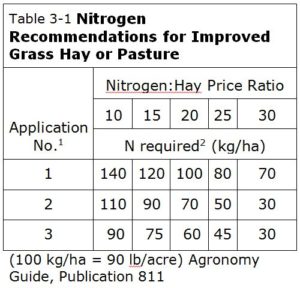Winterkill of forage stands is significant in many parts of eastern Ontario this spring. Both new forage seedings and older stands areeffected. A decision must be made to either keep and manage a reduced stand, or replace the stand with another crop. The first thing that forage growers need to do is to walk their field to assess for winter survival. Dead plants are easy to pull out in most, but not all cases. Note, just because there are green shoots, it doesn’t mean that the plant will survive. Often the plants will put out 2 to 4 inches of new shoot growth, and then die off. You need to dig up a few plants in various parts of the field to take a closer look at the health of the plant roots.
To properly assess forage stands you must inspect the field in several locations. This involves digging up plants and looking for leaf and bud vigour, resistance to bark peeling and a good internal root colour (white to cream colour). Research has found that root resistance to squeezing and the visual appearance of fungal growth on the root surface does not give as accurate an estimation of the alfalfa plant survivability and future yield potential. Roots with broken lateral roots have poor chances of survival, particularly in a dry spring.
So what are the options?
Seeding New Stands
In most situations the preferred option would be to direct seed a new alfalfa or alfalfa, grass stand in a new field. Following last year’s soybeans works well, as there is generally less residue to deal with. Rotate the thin field to corn and use the residue nitrogen as a credit to the corn crop. This can save $25 to $50 an acre. Nitrogen credits from an alfalfa stand seeded last year are 45 kg/ha. For an older alfalfa stand, nitrogen credits can be 110 kg/ha.
Good Grass Content

If the stand still has a good content of grasses left, the application of nitrogen can significantly boost forage yield and quality. For stands with less than one third legume content, the nitrogen rate is based on the ratio between the price of hay and the cost of nitrogen. At hay prices of $146 per tonne and a urea price of $650 per tonne, the ratio is 10 and the recommended nitrogen rate is 140 kg/hectare (kg/ha) (125 lbs/acre) actual nitrogen. If a second cut is planned, an additional 110 kg/ha (100 lbs/ac) can be applied immediately following the first cut. If a third cut is planned, another application of nitrogen immediately following the second cut of 90 kg/ha (80 lbs/ac) is recommended.

Direct Seeding Alfalfa into Existing Stands
If the stand was planted with alfalfa last year, then you can direct seed alfalfa again without the concern of autotoxicity. This is like doing a direct seeding, but will have the disadvantage of having a mix of maturity of plants. Direct seeding alfalfa into older stands usually results in poor stands.
Forage Spring Cereal
If you need an early crop of forage, spring cereal crops such as Oats, Barley and/or Triticale can be planted as a companion crop and harvested early for forage. Forage yields are similar for all three species. Plant as early as possible when soil conditions are suitable. Use the same nitrogen rate that you would for the cereal crop, as the plan would be to harvest the cereal crop as a forage, rather than leave it for grain harvest. If cut early, some regrow of the cereal crop may be in the second cut.
Adding Peas to the cereal companion crop
Research has shown that adding peas with spring cereals will increase Crude Protein by 2 – 4% and decrease NDF by 2 – 6%. To obtain the benefit of the peas, you need to include peas at a 50:50 peas:cereal ratio. This will add to the cost of the forage.
Spring Cereal Forage Yield vs Quality
If harvested at the Boot stage of the spring cereal crop, forage yields have been about 1.6 Ton/acre with Crude Protein at 15.7%, TDN of 65.1%. If delaying harvest until the Milk stage, forage yield increase to about 2.5 Ton/acre, but quality decreases with Crude Protein at 11.2%, and TDN of 61.8%.